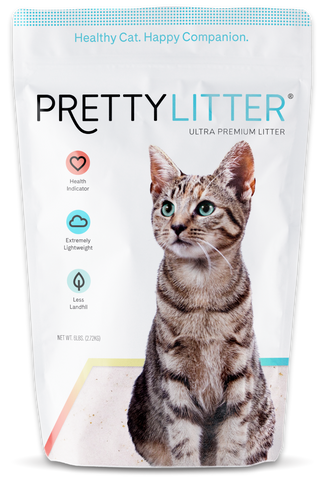Cat Litter That Prioritizes Their
Health & Your Happiness.
Get 20% + a Free Toy
Use Code PRETTYBLOG at Checkout
for 20% Off + a FREE Catnip Toy
If you love cats (like we do), you probably enjoy having other living things around your home (like we do!).
Other than an adorable kitty, nothing quite brightens up a home like a handful of plants.
While you might think that anything leafy and green can only be good for you and your feline roommate, there are some plants that are toxic to cats.
Before you visit the garden section of your favorite home goods store, check the list below to make sure none of your new additions are toxic to your furry friend.
Lilies
The first of many plants toxic to cats, lilies come in a variety of danger levels. Some are harmless, while others can cause minor irritations, and still others can be deadly.
Calla, Peace, and Peruvian lilies each contain oxalate crystals that can cause minor issues for your furry friend. For example, if your cat nibbles on one of these lilies, he may develop irritations in his mouth, on his tongue, and throughout his pharynx and esophagus, which can cause him to drool or exhibit other odd mouth behaviors.
At the worst end of the spectrum, there are lilies that are extremely toxic to cats, including:
-
Asiatic
-
Day
-
Easter
-
Japanese Snow
-
Tiger

Even nibbling on a couple petals or leaves of these plants can cause kidney failure.
Lilies of the Valley are another plant toxic to cats. However, this member of the lily family contains cardiac glycosides, which - if ingestion occurs - can cause diarrhea, cardiac arrhythmia, lowered heart rate, vomiting, and even seizures. If you suspect your cat has potentially ingested one of these types of lilies you should immediately call your local vet and the ASPCA animal poison control center.
Azaleas & Rhododendrons
These plants are members of the same family and neither are friends to felines. If your cat gets her mitts on even just a couple leaves of either of these plants, she could be in serious danger.
Azaleas and rhododendrons are plants toxic to cats that can potentially cause death if the symptoms aren't treated quickly. Symptoms of toxicity from these two plants include excessive drooling, diarrhea, vomiting, and coma.
Oleander

If your cat is an outdoor adventurer, beware. The oleander plant is a common shrub that grows outside and is popular in many neighborhoods. Yet, despite their lovely looks, both the leaves and the flowers of the oleander plant are toxic to cats.
Keep an eye out for oleander plants in your neighborhood – or even in your own yard – and watch out for signs of oleander toxicity, which include severe vomiting and slowed heart rate. Left untreated, this plant can cause death in some cats.
Tulip & Hyacinth Bulbs
Both of these plants toxic to cats produce gorgeous blooms, which makes them extremely popular in outdoor gardens. Both contain similar properties that are dangerous to our feline friends.
In tulips, it's the Tulipalin A and B lactones and in hyacinth, it's the alkaloids. These natural compounds are found in the highest concentration in the bulb of the plant, but the flowers and leaves can be toxic, too.
Signs of poisoning from tulip and hyacinth plants includes diarrhea (which may include blood), vomiting, depression, drooling, and tremors.
Chrysanthemum
Another common household decoration and bouquet feature is the chrysanthemum. This lovely, delicate flower is toxic to cats, dogs, and even horses! Throughout the plant are several toxins, including lactones, pyrethrins, sesquiterpene, and other irritants that can cause diarrhea, dermatitis, vomiting, drooling, and lack of coordination.
English Ivy
Commonly used to cover the soil of potted plants and arrangements, English ivy contains triterpenoid saponins, an organic compound that's also found in other types of ivy.
The leaves of the English ivy are more commonly used for decoration than the berries the plant produces, and, unfortunately, the leaves are the most toxic to cats. Signs of toxicity include abdominal pain, diarrhea, vomiting, and drooling.
Sago Palm
While many of the plants on our list grow outdoors, the sago palm is often kept in small containers indoors and is popular in tropical regions, such as Hawaii and Florida. Both the leaves and the seeds can cause internal bleeding, damage to the stomach lining, vomiting, liver failure, and - in severe cases or if left untreated - death.
Marijuana
With the growing popularity of legalizing marijuana around the country, more and more pet parents are finding out the hard way that marijuana is not safe for kitties (no matter what Bob Marley says).
Daffodils
Yes, daffodils, too. Daffodils, which come from narcissus bulbs, are another of the many plants toxic to cats because they contain lycorine, which causes severe vomiting if ingested. The substance is in the bulbs, leaves, and flowers of daffodils and will cause some serious abdominal discomfort for your little one if ingested.
Signs of lycorine intoxication include slowed breathing, abdominal pain, cardiac arrhythmia, vomiting, and diarrhea.
I know what you're thinking: How can all the most gorgeous plants in your garden be so dangerous to your fur baby? Unfortunately, cats and plants are not the best of friends in the natural world.
Other Plants Toxic to Cats
The reality is eating any plant matter could upset your cat's digestive tract, especially if it's a new thing she's nibbling on. There are several more plants that are toxic to cats, so be sure to check out your new favorite foliage before adding it to a space your kitty calls home.
If you think your fur baby may have been exposed to one of these plants toxic to cats, call your vet or the ASPCA Animal Poison Control Center at (888) 426-4435 right away. If you can, bring the plant in with you to the vet so your vet can prescribe the precise treatment for the specific plant your cat has ingested.
Searching for cat safe plants for your home? Check out our list of best plants for cats that are safe to eat. Now, on a more cheerful note, we'd love to see a snapshot of your fur baby getting along with the many non-toxic plant varieties! Snap a gorgeous #floraandfauna pic and tag us on Instagram @PrettyLitterCats.
Do you have a beautiful cat? Let us know in the comments!
----
Don't forget to follow us on Instagram: @prettylittercats
----

Delivered straight to your front door, every month. We’ll even pay your shipping.
For a limited time only, get 20% off your first PrettyLitter order. Enter code “LOVE20” at checkout. Redeem Now!

Tired of your
home smelling like
you have a cat?
20% + A Free Toy
Use code PRETTYBLOG

















